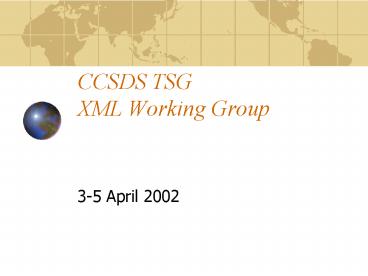CCSDS TSG XML Working Group - PowerPoint PPT Presentation
1 / 19
Title:
CCSDS TSG XML Working Group
Description:
Klaxon stay inside. Bell move to carpark outside. Lunch: Cafeteria. Meeting Dinner: no-host dinner Thursday evening. 3-5 April 2002. CCSDS TSG XML Working Group ... – PowerPoint PPT presentation
Number of Views:45
Avg rating:3.0/5.0
Title: CCSDS TSG XML Working Group
1
CCSDS TSGXML Working Group
- 3-5 April 2002
2
Logistics
- Internet connections DHCP
- Voltage 240V
- Emergencies
- Klaxon stay inside
- Bell move to carpark outside
- Lunch Cafeteria
- Meeting Dinner no-host dinner Thursday evening
3
Overview of Aug 2001 XML w/s
- in the rapidly developing XML world we needed to
work quickly - adopt or adapt existing work where possible
rather than developing entirely new things - need to provide supporting software for any
standards we produce in order to facilitate the
use, but difficult to maintain - COTS tools is to be preferred wherever possible
- 2 working groups
- Data Description and Space Operations
- Data Packaging
4
- Conclusion XML has many potential areas of
applicability in the Space Domain and CCSDS is
the correct organisation under which to pursue
this work. - A resolution for the Management Council
5
Resolution for MC
- The Management Council resolves to set up an
Ad-Hoc XML Technical Working Group with the
following charter - Vision
- Space domain activities are characterized by an
end-to-end model of the data, starting with the
proposals and ending with the data archives, with
standard terminology and definitions for items in
common.
6
Charter
- The charter proposed for the CCSDS XML TWG is to
develop standards for XML in space applications.
To this end, the TWG should do the following or
encourage others to - Provide a forum for discussion and presentation
of XML issues - Provide a means for dissemination of standards
for XML space applications, such as web pages,
CCSDS documentation (white books, red books,
green books) - Propose examples to show the benefits from usage
of XML - Provide templates for XML use in the space domain
- Work with other standards bodies, such as the OMG
Space Domain - Examine the XML tools
- Encourage the development of more tools
- Expose the XML communications wherever possible
- Make comparisons among current tools and
approaches to expose commonalities and
differences - Propose a naming authority approach and related
framework
7
Goals
- The goals for the CCSDS XML TWG are the
following - Establish standards for XML in space
applications, including - High level data model (UML)
- Related XML schema
- High level data dictionary
- Baseline glossary/vocabulary
- Meta data
- Interchange formats
- Formats
- Interfaces
- Actively encourage demonstration project(s)
- Plan XML implementation so as to encourage rapid
adoption - Develop a library of project templates
- Provide a means of measuring conformance to
standards - Find or develop an XML tool to populate an XML
schema for space applications
8
Applications of XML for Space
Spacecraft Configuration
Space Domain
Relay Satellite
Instrument Control
Spacecraft / lander
Spacecraft and Scientific Instruments
Metadata Access
Data Archival Distribution
External Science Community
Data Processing Control
Data Archive
Data/Information Distribution
Spacecraft Goals
Data Processing
Service Requests
Spacecraft and Scientific Instruments
Data Analysis and Modeling
Data Acquisition and Command
Mission Operations
Instrument /Sensor Operations
Data Modelling
System Configuration Control
Science Team
Operations Control
Operations Planning
Science Planning
9
Objectives
- Define an initial Information Architecture
- Update how to proceed recommendations for TSG
and MC
10
Approach
- What do we see as the scope of the Architecture?
- What modelling techniques to use (UML, XADL, XML,
?) - How do we incorporate recognizable techniques,
including models, data dictionaries,
repositories, services, etc - Agree on approach and attempt to partition effort
for parallel work
11
Information
- Data are the uninterpreted signals that reach
our senses every minute in time by the
zillionsInformation is data equipped with
meaningKnowledge is the whole body of data and
information that people bring to bear to
practical use in action, in order to carry out
tasks and to create new information. (Sc
hreiber et al. 1998)
12
Layered GRIDs e-science in silico
Data to knowledge
Control
13
Challenge Supporting the Knowledge Life Cycle
14
Service Oriented Architectures
Find
Publish
Bind
15
Interoperability Stacks
- Wire stack
- Description stack
- Discovery stack
16
Wire stack
SOAP Headers
SOAP
XML and SOAP
HTTP(s), SMTP, FTP etc
17
Description stack
WSFL/XLANG
WSEL
WSDL
WSDL
XML Schema
18
Discovery stack
UDDI
ADS/DISCO
19
Open Grid Service Architecture (OGSA)
- Architecture
- well defined set of basic interfaces from which
can be constructed interesting systems - Grid Service
- Potentially transient
- Stateful
- Reliable and secure invocation
- Lifetime management
- Notification
- Credential management
- Virtualization































